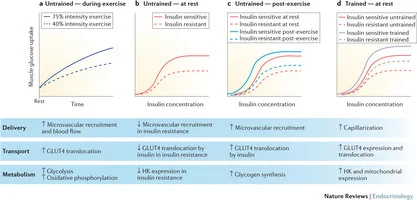Exercise-stimulated glucose uptake — regulation and implications for glycaemic control
Physical activity is one way to enhance insulin sensitivity, manage blood sugar and reduce markers of inflammation for those with insulin resistance or diabetes. According to research exercise can be used as therapy for those with diabetes - as glucose control is managed independently of the effects of insulin. [2][3][5]
Recent research conducted by the University of Copenhagen and published in the journal Nature, involves understanding how glucose metabolism is regulated with a focus on skeletal muscle.
Sylow, Lykke et al., (2016) - Exercise-stimulated glucose uptake — regulation and implications for glycaemic control
Key points from this study: [1]
glucose metabolism can be restored (even in insulin resistant muscle) for up to 48 hours after exercise.
glucose uptake by skeletal muscle can increase by up to 50-fold during exercise.
long-term exercise training improves the effect of insulin on glucose uptake in muscle at rest.
Diet is often viewed as the primary intervention for managing insulin resistance and metabolic syndrome [4] but the combination of diet and physical activity is even more powerful especially when you consider insulin is not even required to manage blood glucose (when physically active) [5]. Movement is medicine.
Engaging in functional fitness training exercises, such as Primal Play, will help you manage blood glucose through appropriate physical activity.
RELATED POSTS:
References:
[1] Sylow, Lykke et al., (2016) “Exercise-stimulated glucose uptake — regulation and implications for glycaemic control.”, Nat Rev Endocrinol
[2] Ryan AS, et al., (2014) “Aerobic exercise and weight loss reduce vascular markers of inflammation and improve insulin sensitivity in obese women.”, J Am Geriatr Soc. 2014 Apr
[3] Colberg SR, et al., (2013) “The Big Blue Test: Effects of 14 Minutes of Physical Activity on Blood Glucose Levels.” Diabetes Care February 2013 vol. 36 no. 2 e21
[4] Ford ES, et al., (2005) “Sedentary behavior, physical activity, and the metabolic syndrome among U.S. adults.”, Obes Res. 2005 Mar;13(3):608-14.
[5] Ploug, T., et al., (1984) "Increased muscle glucose uptake during contractions: no need for insulin." Am. J. Physiol


![The Role of Physical Activity in Breast Cancer Prevention [Download]](https://images.squarespace-cdn.com/content/v1/567155dca2bab819494ef093/1583158768708-2PFXZ5UAFYT8B2IC7YAE/Exercise-And-Breast-Cancer-Prevention.png)





5 Ways Exercise Supports Immune Function